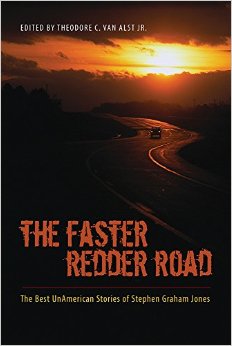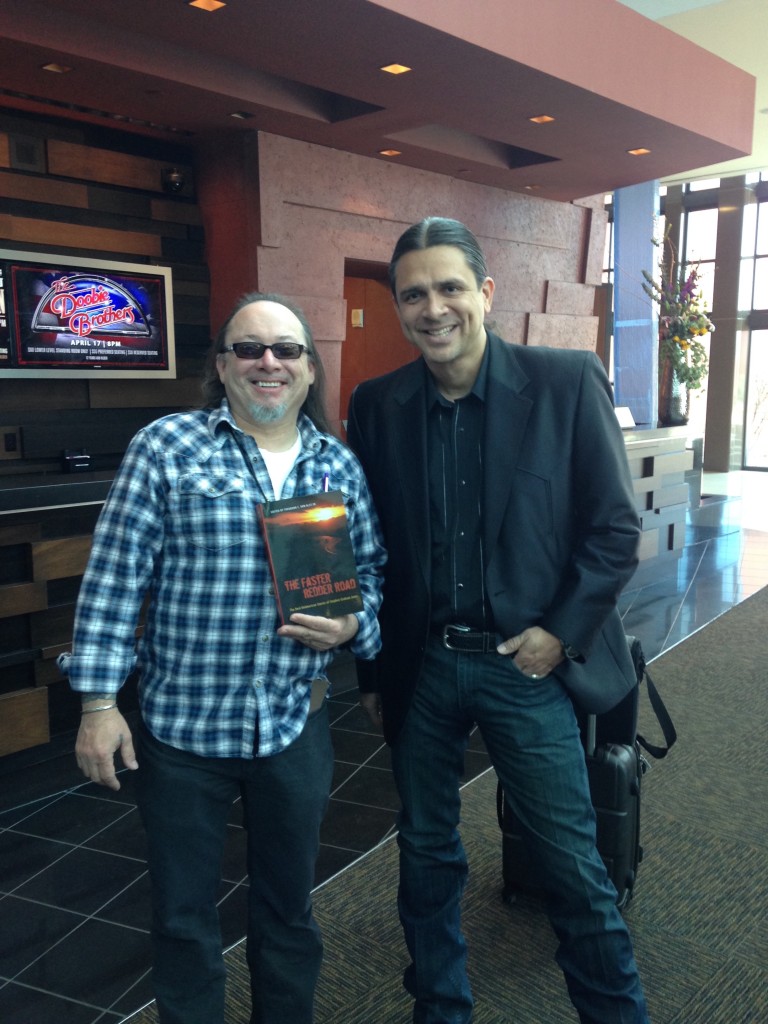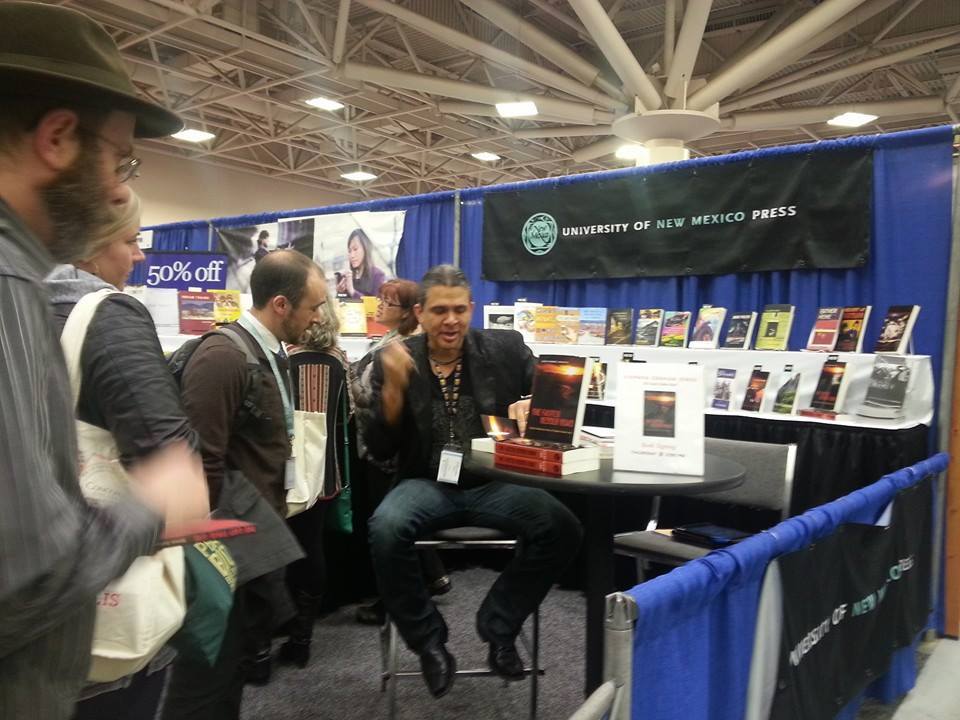 From UNM:
From UNM:
“This collection showcases the best writings of Stephen Graham Jones, whose career is developing rapidly from the noir underground to the mainstream. The Faster Redder Road features excerpts from Jones’s novels—including The Last Final Girl, The Fast Red Road: A Plainsong, Not for Nothing, and The Gospel of Z—and short stories, some never before published in book form. Examining Jones’s contributions to American literature as well as noir, Theodore C. Van Alst Jr.’s introduction puts Jones on the literary map.”
From me:
In 1995, I think it was, I was living in Apple Creek apartments in Denton, Texas with my new wife. I was in the PhD5 program at UNT, studying with William J. Cobb, a program I’d abandon momentarily for FSU. But, for the moment I was there, taking a critical theory course from a Dr. Preston (brilliant, wonderful dude; I still come back nearly daily to what-all he taught me), I was given permission to write a story instead of a paper. So of course I jumped on that, especially since it was my idea, my bargain, “I’m not a critic,” all that. Only guideline for the story was it had to engage or be in dialogue with some article or book we’d been reading for class. The story I kicked up—actually I kicked two up, both of which got published—was to be my first-ever publication in a national rag, “Paleogenesis, 1970.” That “1970” was how I completely disguised myself, as I’m born in 72. Nobody could ever see through a scrim like that, could they? The mag was Black Warrior Review, a place that’s steadily rejected me ever since then. And what the story was meant to be in dialogue with was some of the metafiction we’d been delving into—a house of mirrors it’s hard to find your way up from. Which is just all kinds of fun. And I mention this all for two reasons: one, that story’s included in here. First time it’s seen print in nearly twenty years. Two (really, there’s about to be three reasons). Two, this gas station in this story, it would be the setting for pretty much every story I wrote for a year or two after this, in one way or another. There’s this story I had back then “The Ballad of Stacy Dunn” that’s like this story, opening up into scenes. And there was a story called “Navasota Moon,” which is this story’s narrator in a different part of his life. And I wrote a story called, I think, “Thirteen” that got published in some departmental thing, I think, that’s also this narrator. I thought I’d found what I was meant to be doing, I mean. It’s a good feeling to have when you’re twenty-four. Anyway, the third reason I mention all this: all these stories in here, UNM and Theo let me do story notes for them, like I’ve done with some of my other collections. Only, this time, to insure they stay with the story if it gets copied out, instead of being stacked at the end, they each follow their story. Here’s the one that goes with “Paleogenesis, 1970”:
Paleogenesis, Circa 1970—The original of this is “The Ballad of Stacy Dunn,” a story I wrote to death in grad school. I don’t know why, but for some reason one of the most permanent images rattling around in my head, it’s of a couple slowdancing at a truckstop at night. Behind them are the quilted steel doors of a forty-foot trailer. And it’s a perfect moment. Too, this was the first story I ever had published, I think. Or, published in a big place: Black Warrior Review. And it’s hardly at all like the “Stacy Dunn” version. That one’s got all kinds of stuff going on, as I recall. This one’s just me sitting in a booth. Or, ‘me,’ I should say; putting that “1970” into the title at the last moment, that’s my super-hiding abilities (I’m born in 72). I think this is the story where I figured out what would become one of my principles with fiction, too: ‘grey’ is spelled like that. But also, the way the rain falls, in words, that’s also something I’m very attached to. I’m very interested in the bridges between fiction and this place. Permeable membranes, yes. I’m always trying to look through. And, I’ll forever remember BWR calling on the phone to accept this piece, and to say I was getting $175 for it. It was amazing. I stood there in my new, just-married apartment with my hand on the phone and I honestly felt like it was all beginning, like this is where it starts. And then the phone rang under my hand. I held it up to my ear. It was the police. My mom had had just been in a head-on collision in Midland, Texas. Right directly in front of the emergency room of the hospital, so they could just wheel her gurney right in from the street. When that call was done, I held my hand on the phone for a little bit more, waiting for whatever was going to happen next.
And, I haven’t compared, but I think the TOC is still pretty much:
1. FAST RED ROAD (excerpt)
2. Lonegan’s Luck
3. So Perfect
4. The Wages: An Argument
5. State
6. Captivity Narrative
7. Exodus
8. NOT FOR NOTHING (excerpt)
9. Father, Son, Holy Rabbit
10. Carbon
11. To Run Without Falling
12. Discovering America
13. THE GOSPEL OF Z (excerpt)
14. The Parable of the Gun
15. Paleogenesis, Circa 1970
16. Interstate Love Affair
17. Uncle
18. Raphael
19. Decomposition of a Conversation
20. Rocket Man
21. Neither Heads Nor Tails
22. ALL THE BEAUTIFUL SINNERS (excerpt)
23. Lunch
24. Rendezvous with Sula Prime
25. Deer
26. Little Lambs
27. Welcome to the Reptile House
28. Adultery: A Failing Sestina
29. Screentime
30. DEMON THEORY (excerpt)
31. Boys with Guitars
32. No Takebacks
33. Billy Hanson
Too, this is a book that never would have happened had Theo Van Alst not had the idea for it. Many thanks. And, initially I was concerned, as having a selected works, isn’t that like a headstone on your career? Don D’Auria gently corrected me at World Horror in Portland: a collected works means you’re dead. A selected works is more like a volume 1.
Here’s Theo and me at the Isleta Casino for NALS in New Mexico, the first time either of us saw the book:

and here’s me signing it for the first time at AWP in Minneapolis:
 and here’s a couple write-ups:
and here’s a couple write-ups:





2 thoughts on “The Faster, Redder Road”